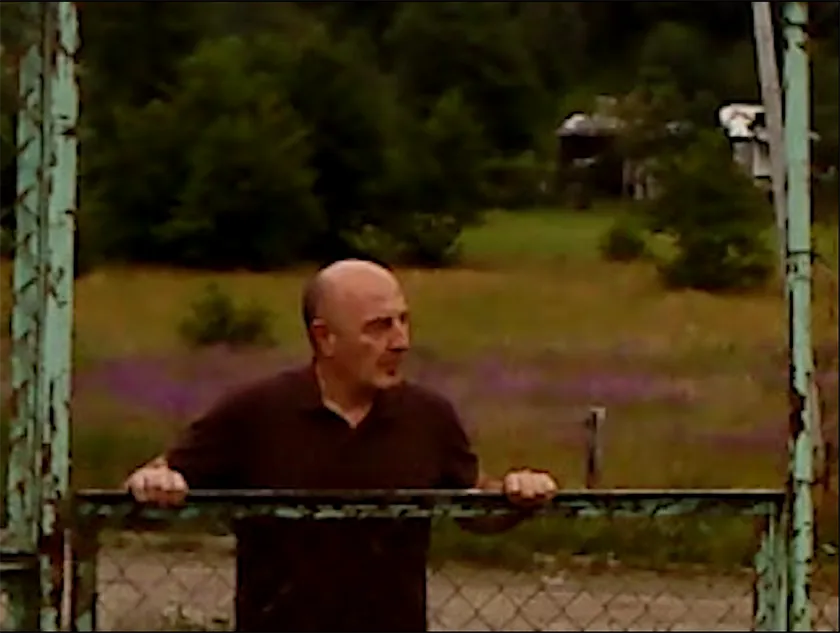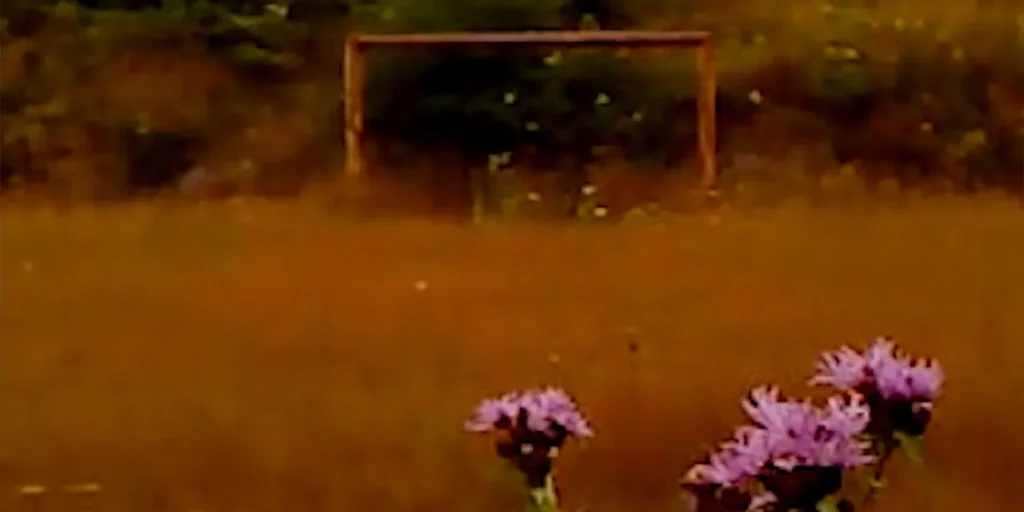Shot entirely on a Sony Ericsson, Alexandre Koberidze’s Dry Leaf journeys through rural football fields in Georgia for an artful, distinctive and singular film.
Writer-Director: Alexandre Koberidze
Genre: Drama
Run Time: 186′
BFI London Film Festival Screening: October 11-13, 2025 (“Dare” Strand)
U.S. Release Date: TBA
U.K. Release Date: TBA
Dry Leaf is a three-hour film shot entirely on an old Sony Ericsson phone. That sentence is a good description of what to expect from this movie (and whether it will be your thing), but it also doesn’t quite capture the brilliant peculiarities of the man behind it. Georgian editor-writer-director Alexandre Koberidze has already proved to be a unique filmmaker. His last film was What Do We See When We Look at the Sky?, where he told an intimate love story by emphasising small slices of Georgian life.
Now he has gone in a more abstract direction, using a low-res camera for a trip through the rural parts of his home country. It results in an artful, distinctive and singular film that really positions Koberidze as an exciting voice in arthouse cinema.
The film starts with a letter left by a woman named Lisa to her parents. A photographer for a sports magazine, she has disappeared and asks her parents to trust her, saying that “time will pass, and we’ll see each other again.” One month later, her father Irakli (played by David Koderidze, the director’s father) is determined to find her. He learns that Lisa was working on a project to photograph football pitches across different rural villages in Georgia, with her colleague Levani (Otar Nijaradze) set to write about them. So Irakli decides to retrace her daughter’s steps with the help of Levani, though there are two complications.
Firstly, as a narrator explains, “Levani, like many others in this film’s reality, is invisible.” We hear Levani’s voice, we even see Irakli interact with where he should be by sticking his hand out for a handshake – we just can’t see him. Secondly, Levani can only vaguely remember the exact locations of these fields (maybe even less than that). This set-up establishes Dry Leaf as part-road trip movie and part-mystery, as Irakli and Levani are led in all sorts of directions, unable to find someone who recognises Lisa. However, it soon becomes clear that this is really a film centred on what the pair – and the film – will discover. It’s about the journey, not the destination.
Let’s start with the Sony Ericsson, which Koberidze previously used in his 2017 debut, Let the Summer Never Come Again. Where What Do We See…? was crisp, Dry Leaf is pixellated, hazy and unclear. The initial effect is one of disorientation, as each shot is so compressed and distorted that objects can be hard to make out. But whilst it takes a while to get accustomed to the images produced, you eventually start to notice some distinguishing features. Changes in light take the camera a few seconds to register. Rain can obstruct the Ericsson’s lens and leave marks on the frame. And in nighttime scenes, the only source of light may come from Irakli’s car headlights, which are then overexposed to the point of blinding you.
A lack of clarity will be an issue for some, but Koberidze (who now serves as DP as well) makes the most out of the Ericsson and its sharp contrasts. He also manages to experiment with techniques, incorporating camera pans and digital zooms. Consequently, almost every shot is attention-grabbing. Some are entrancing, such as a sequence at a car wash. Some even see blurs turn rural scenes into vivid landscapes, as if they have been formed by brushstrokes rather than a decades-old phone. All the while, these beautiful visuals are accompanied by shifting, enigmatic, sometimes trickling pieces of music by Koberidze’s brother Giorgi (making this a family affair).
With a 186-minute runtime and unquestionably languid pacing, Dry Leaf’s story can feel drawn-out in places, particularly towards the end. At the same time, with Koberidze, it’s never really about the story. Just like What Do We See…?, this is a film defined by worldbuilding details, to the point that these different places and people become the main focus. Here, they can take the form of traditional town gatherings, close-ups of football statues or Irakli being kind towards donkeys and stray dogs.
Irakli also hears from two youngsters about grape harvests spoiled by the spring snow. He finds some ripe apricots. He helps put a goalpost back up for a boy wearing a Napoli 77 shirt. Notably, though we cannot see the name on the back, that is the shirt once worn by Georgian football icon Khvicha Kvaratskhelia (now at Paris Saint-Germain). And whilst that is a relatively minor reference, it speaks to Koberidze’s passion for the sport that forms the reason for this trip. There are so many football pitches in these villages, and so many children gathering to play on them.

The film’s title comes from a football term pioneered in the late 1950s by Brazilian midfielder Didi, and refers to a spectacular kick that moves unpredictably in the air, like a leaf falling from a tree. In his director’s note from when the film premiered at Locarno, Koberidze says it is “much like our characters who surrender to the journey,” but that could be said for his two previous features as well. They were also about characters surrendering to the winds of change, fate or forces beyond their control, rendered with an eye so observant that they become almost all-encompassing in scale. And that same quality is present in Dry Leaf.
It is a film of wonderful spontaneity that lies in in the interactions Irakli has with random (sometimes invisible) strangers, in the natural landscapes of the villages and in the remarkable shots created by the Sony Ericsson. It is wildly unconventional and strange. However, if you are fully onboard with Koberidze’s vision, it becomes a richly rewarding experience.
Dry Leaf: Movie Plot & Recap
Synopsis:
Irakli searches for his daughter Lisa, who has disappeared whilst photographing rural football fields across Georgia. Accompanied by her friend Levani, Irakli takes a road trip through the fields Lisa has been visiting.
Pros:
- Artful, distinctive and singular – Alexandre Koberidze has made another film worth watching.
- It takes a while to get accustomed to the Sony Ericsson, but it is an inspired choice that produces some beautiful visuals.
- The film is full of brilliant worldbuilding details.
Cons:
- A lack of clarity in the images will be an issue for some.
- With a three-hour runtime, it can feel drawn-out in places, particularly towards the end
Dry Leaf will be screened at the BFI London Film Festival on 11-13 October, 2025.

